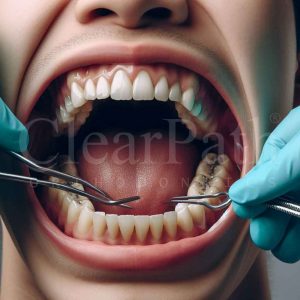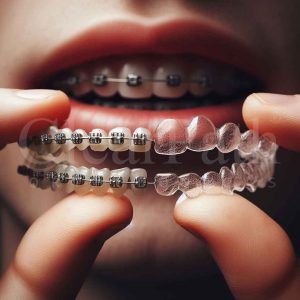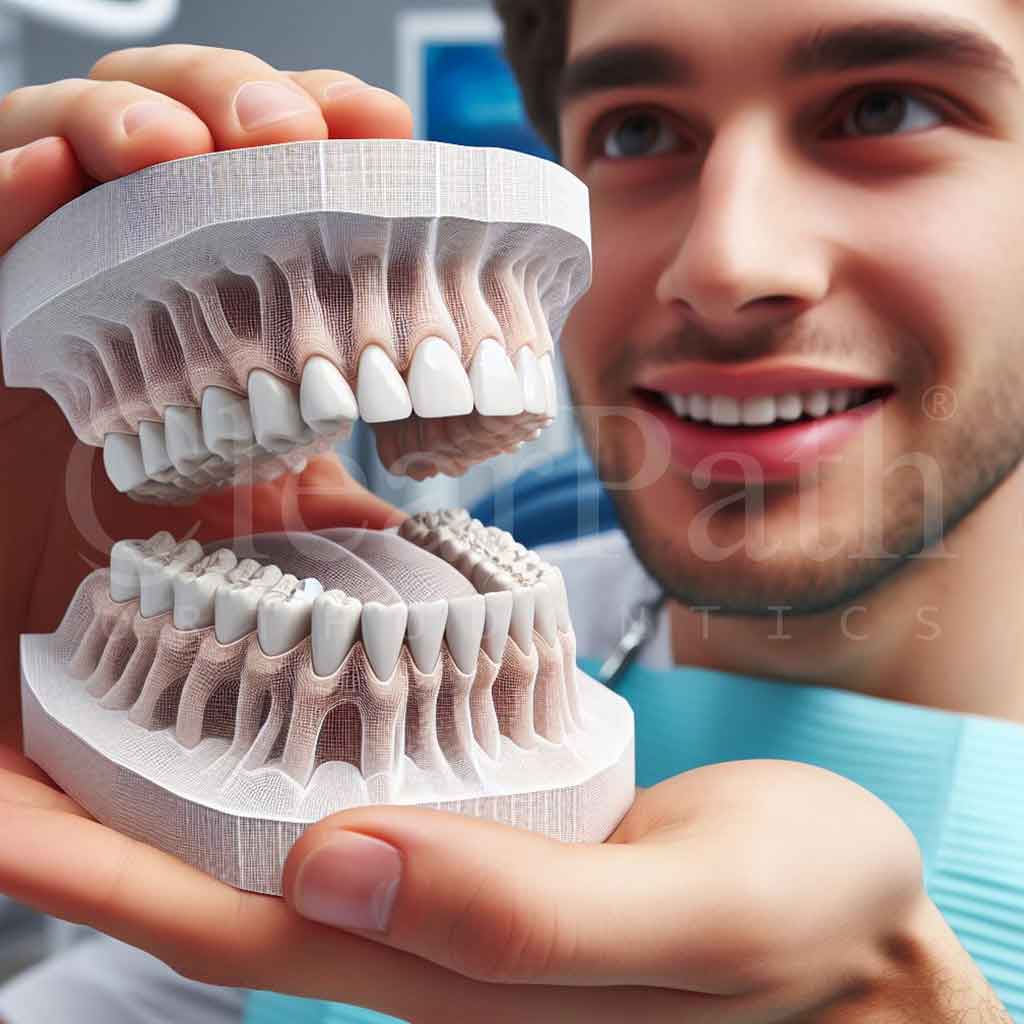Ever noticed how a smile can brighten even the gloomiest day? It’s the universal language of kindness.
But what happens when your teeth decide to start jostling for space and creating a chaotic crowd in your mouth?
If you’ve ever found yourself hesitating to flaunt your smile because of misaligned or overlapping teeth, rest assured, you’re not alone.
Dental crowding is a common concern. It isn’t just a minor inconvenience; it’s a bigger deal than you might think.
Overcrowded teeth aren’t just about aesthetics; they can cast a shadow on your oral health and, in turn, mess up the overall quality of life.
Dental Crowding: A Silent Culprit
The repercussions of overcrowded teeth extend beyond the surface. It’s not just about appearances; it’s about your health & well-being.
Crowded teeth create a breeding ground for dental issues, from increased vulnerability to cavities and gum disease to the discomfort of navigating hard-to-reach nooks during your oral care routine.
The Weight of Self-Consciousness
Feeling self-conscious about your smile is more than just a passing discomfort. It can affect your confidence, your interactions, and even your willingness to share your joy through a simple, genuine smile.
The impact is not merely cosmetic; it’s a nuanced dance between oral health and the ability to express yourself freely.
Table of Contents
ToggleSo…what is teeth overcrowding, and why does it occur?

The scientific term for overcrowded teeth is dental crowding, a condition that arises when the jaw lacks sufficient space for the proper alignment of all teeth.
This often manifests in teeth that are twisted, tilted, overlapping, or pushed out of their intended alignment.
While overcrowded teeth can affect both the upper and lower jaws, it tends to be more prevalent in the lower set of teeth.
What causes overcrowding teeth?
Consider dental crowding as a complex puzzle where the pieces resist aligning seamlessly.
The jaw, analogous to a meticulously designed space, often falls short in affording ample room for the teeth to align with grace and precision.
As a consequence, a multitude of misalignments unfolds, resulting in teeth that lack harmony in their arrangement.
Both the upper and lower jaws bear the burden of this misalignment, with the lower teeth frequently entangled in the intricacies of this dental dilemma. The lower jaw, responsible for accommodating a substantial portion of our dental structure, often succumbs to spatial limitations, orchestrating a symphony of misalignments that compromise both oral health and overall aesthetics.
Various factors contribute to this misalignment, each playing a distinctive role in the orchestration of this dental challenge.
Analyzing the Influences Behind Dental Misalignment
Genetic Predisposition: Genetic factors manifest as a pivotal element. Consider a scenario where teeth, genetically predisposed to larger proportions, clash with a jaw of more modest dimensions, or vice versa. This incongruity is dictated by the inherent genetic makeup.
Environmental Dynamics: Following suit, environmental factors come into play. Early or delayed loss of baby teeth, improper eruption of permanent teeth, the emergence of extra teeth, and habits like thumb-sucking or tongue-thrusting collectively shape the narrative of jaw development.
Aging Variables: Lastly, aging introduces its own nuances to the ballet. Changes in facial structure, the subtle cadence of bone loss, and the gradual wear of teeth contribute to the evolution of dental alignment over time. This aging ballet adds yet another layer to the intricate dance of dental misalignments.
The Domino Effect: Complications Arising from Overcrowding
As we delve into the intricacies of dental crowding, we see that its impact extends beyond the aesthetic realm.
Consider a canvas envisioned with the intention of smooth, parallel strokes, only to result in a disconcerting collision of lines.
This analogy encapsulates the visual dissonance introduced by overcrowded teeth—a canvas marked by twists, overlaps, and tilts, detracting from the intended beauty of a radiant smile.
The implications of overcrowded teeth are profound, giving rise to a spectrum of potential dental challenges.
These issues transcend mere appearances, manifesting elevated risks of tooth decay, gum disease, and difficulties associated with the meticulous cleaning of hard-to-reach areas.
Furthermore, misaligned teeth contribute to a range of discomforts, from jaw pain and headaches to uneven wear on the teeth, posing comprehensive threats to oral health.
The consequences of overcrowded teeth extend into multifaceted dimensions, mainly:
Aesthetic Considerations: Beyond surface-level concerns, dental overcrowding bears upon self-image, causing dissatisfaction with one’s smile and instigating feelings of embarrassment or insecurity about personal appearance.
Functional Implications: The functional aspect takes precedence, revealing challenges in fundamental activities such as chewing, biting, speaking, or breathing. The presence of pain or discomfort in the jaw, teeth, or gums underscores the functional complexities introduced by dental crowding.
Oral Health Impacts: In the front lines of oral health, risks escalate. Tooth decay, gum disease, bad breath, and potential tooth loss become formidable prospects, primarily due to the inherent difficulty in maintaining proper hygiene amid overcrowded teeth. The environment created by dental misalignment becomes a conducive habitat for plaque and bacteria proliferation.
In essence, the intricate nature of dental crowding surpasses superficial concerns. It weaves challenges that influence self-perception, daily functionalities, and the preservation of optimal oral health.
As we navigate these intricacies, addressing overcrowded teeth emerges as a holistic pursuit, encompassing overall well-being and the restoration of a harmonious, visually appealing smile.
How can overcrowding teeth be treated?
The journey to address overcrowded teeth is as unique as the individuals seeking intervention. The severity of the condition, the patient’s age, and their individual preferences all play pivotal roles in determining the most fitting course of action.
Let’s explore some impactful treatment options:
Dental Braces: Precision in Metal or Ceramic Form
Enter dental braces – a stalwart in the orthodontic arsenal. These metal or ceramic devices, connected by wires and rubber bands, exert a gentle yet persistent pressure on the teeth. This gradual coercion guides them into their rightful positions.
Effective for tackling moderate to severe dental crowding, braces, however, come with their share of nuances. They are noticeable, bring about a measure of discomfort, and necessitate meticulous maintenance.
Clear Aligners: The Discreet Revolution
For those seeking a more inconspicuous route, clear aligners emerge as a discreet revolution. Transparent plastic trays snugly fit over the teeth, orchestrating a subtle dance that nudges them into their desired alignments.
Removable, comfortable, and virtually invisible, clear aligners offer an ideal solution for mild to moderate dental crowding. However, success hinges on the patient’s commitment to wear them for at least 22 hours daily.
Tooth Extraction: A Surgical Last Resort
In the realm of extreme cases, tooth extraction takes center stage. This surgical procedure involves the removal of one or more teeth, creating the necessary space in the mouth. Reserved as a last resort when dental crowding reaches severe proportions, tooth extraction isn’t without its risks.
Potential complications include bleeding, infection, and alterations in bite dynamics.
Choosing the Right Path: A Personalized Decision
As we weigh the options, it’s crucial to recognize that the choice of treatment is a highly personalized decision. Each avenue presents its unique set of advantages and challenges. The severity of dental crowding, coupled with individual preferences and lifestyle considerations, ultimately shapes the course of action.
Whether one opts for the precision of dental braces, the subtlety of clear aligners, or contemplates the gravity of tooth extraction, the goal remains constant – to carve a path toward dental harmony.
In this journey, the conversation between patient and practitioner becomes pivotal, guiding the way towards a radiant, well-aligned smile.
Traditional Treatments: Braces, Wires, and Metal Smiles

Throughout orthodontic history, traditional braces have been the stalwart solution for wrangling overcrowded teeth into submission.
Yet, effectiveness often comes at a price, and the tale of braces is no exception. These have their own set of challenges.
As uncomfortable as they are, they also pose a hurdle to effective oral hygiene, creating a labyrinth for toothbrushes and floss. The discomfort extends beyond the physical realm, sparking a tale of self-consciousness, particularly among adults navigating the professional and social spheres.
Moreover, the prospect of an extended treatment duration adds another layer to the narrative. As time stretches, many find themselves at the crossroads, reconsidering the path of traditional braces.
The weight of discomfort, hygiene impediments, and prolonged treatment becomes a formidable factor in the decision-making process.
Invisible Braces: The Game-Changers in Orthodontics

Invisible braces are a modern solution that has revolutionized the field of orthodontics. Unlike their conspicuous metal counterparts, invisible braces offer a discreet and comfortable way to address overcrowded teeth.
The clear aligner technology has gained immense popularity for its effectiveness and aesthetic appeal.
How can invisible braces correct overcrowding teeth?
These are a contemporary and discreet avenue for correcting overcrowded teeth and various forms of malocclusion or misalignment.
These custom-made plastic trays seamlessly embrace your teeth, orchestrating a gradual movement toward the desired alignment.
Unlike their traditional metal counterparts, clear aligners embody a set of distinctive advantages:
| Clear Aligners | Benefits |
|---|---|
| Invisibility | Picture a solution that operates incognito. Clear aligners are virtually imperceptible, sparing you from the unwanted attention often associated with visible dental corrections. |
| Removability | The ability to take a pause when needed. Clear aligners can be easily removed during meals, allowing you to relish your favorite foods without constraints. Additionally, the removal facilitates a thorough oral hygiene routine, ensuring brushing and flossing are unhindered. |
| Comfort | Bid farewell to wires and brackets that irk your mouth and gums. Clear aligners prioritize comfort, applying gentle and consistent pressure to guide your teeth without causing irritation. |
| Convenience | Empowering you with control. Clear aligners grant the convenience of self-management. Changing them at home every week or two minimizes the need for frequent visits to your dentist or orthodontist for adjustments. |
Beyond addressing overcrowded teeth, clear aligners prove versatile in managing a spectrum of issues such as overbite, underbite, crossbite, gap teeth, or open bite.
The treatment duration spans from 6 to 18 months, contingent on the specifics of your case.
In the landscape of dental innovation, invisible braces emerge as not just a correctional tool but a transformative experience.
A fusion of technology and artistry, they redefine the journey toward dental alignment, offering a discreet and effective path to a confident and harmonious smile.
Why choose ClearPath Ortho for your invisible braces?
In the pursuit of a confident, healthy smile, invisible braces emerge as a revolutionary solution for overcrowded teeth.
If you’re prepared to initiate your journey towards a straighter, more radiant smile, ClearPath Orthodontics is your steadfast companion in this transformation.
A leading provider of custom clear aligners both in Pakistan and abroad, we take pride in offering high-quality, customized, and affordable clear aligner trays poised to transform both your smile and your life 🤓.
To book your invisible braces, just fill out the form below ✍.
Our friendly customer service reps will take over from there – and guide you through the entire process.
Simple!











